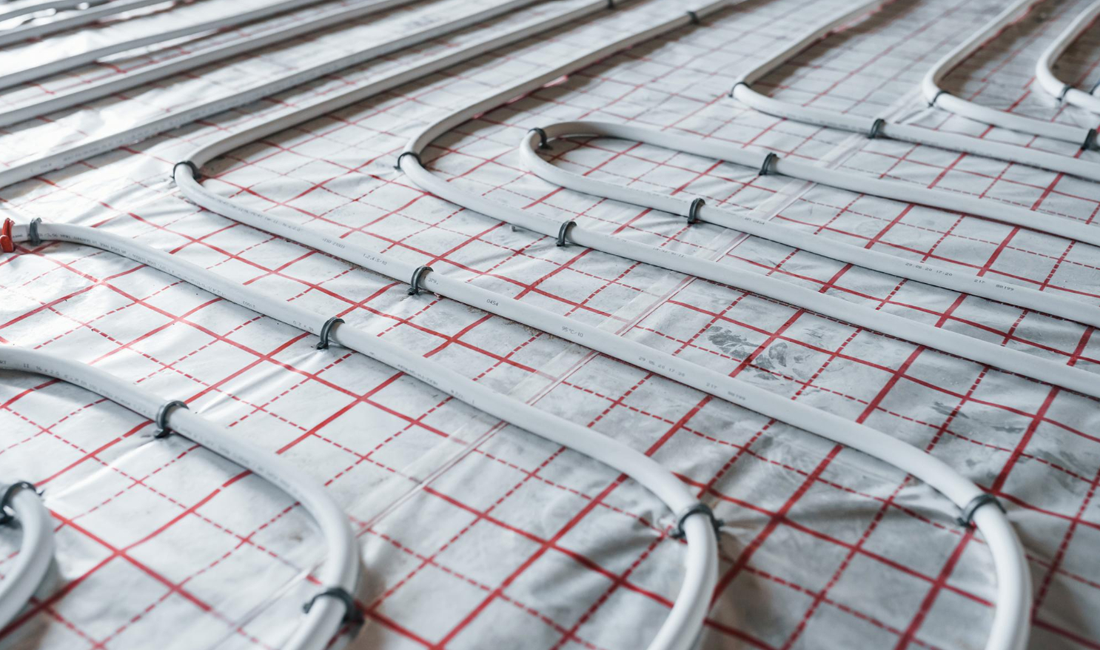Underfloor heating has revolutionised the way we heat our homes, providing an efficient and comfortable alternative to traditional heating systems.
In this comprehensive guide, we’ll delve into the world of underfloor heating, exploring its various types, the costs associated with running and installing them, as well as the multitude of benefits they offer for homeowners.
What is Underfloor Heating?


Underfloor heating is a radiant heating system installed beneath the floor surface, providing a gentle and even distribution of heat throughout the room. Unlike conventional heating methods that rely on radiators or forced air, underfloor heating warms the space from the ground up, resulting in cosy and consistent warmth.
This radiant heat transfer not only keeps the floor pleasantly warm but also ensures that the heat rises uniformly throughout the room, eliminating cold spots and creating a comfortable living environment.
Electric Underfloor Heating (Dry)
Electric underfloor heating systems, also known as ‘dry underfloor heating’, utilise heating cables or mats that are installed directly beneath the floor covering. This type of system is versatile, compatible with various floor types, and can be easily retrofitted into existing spaces.
Electric underfloor heating offers precise temperature control with the use of thermostats, allowing homeowners to adjust heating settings for individual rooms. The installation process involves laying the heating elements and connecting them to the electrical supply.
While the upfront installation cost may be slightly higher compared to other systems, electric underfloor heating is a popular choice for smaller areas and individual room heating due to its ease of installation and control.
lectric Underfloor Heating (Dry)
Electric underfloor heating systems, also known as ‘dry underfloor heating’, utilise heating cables or mats that are installed directly beneath the floor covering. This type of system is versatile, compatible with various floor types, and can be easily retrofitted into existing spaces.
Electric underfloor heating offers precise temperature control with the use of thermostats, allowing homeowners to adjust heating settings for individual rooms. The installation process involves laying the heating elements and connecting them to the electrical supply.
While the upfront installation cost may be slightly higher compared to other systems, electric underfloor heating is a popular choice for smaller areas and individual room heating due to its ease of installation and control.
Cost of Running Underfloor Heating


Underfloor heating offers notable cost benefits compared to traditional heating systems. The running costs of underfloor heating depend on various factors, including the type of system, the size of the area being heated, insulation levels, and thermostat settings.
Due to the lower operating temperatures required for underfloor heating, energy consumption can be reduced, resulting in lower energy bills. Additionally, the even heat distribution eliminates the need for additional heat sources, such as radiators or space heaters, further contributing to cost savings.
Homeowners can also take advantage of energy management strategies, such as programmable thermostats and zoning, to optimise their underfloor heating system and maximise energy efficiency.
Cost of Installing Underfloor Heating
The installation cost of underfloor heating varies depending on several factors, including the chosen system type and the complexity of floor preparation required.
Electric underfloor heating is generally less expensive to install compared to water-based systems since it requires less groundwork and does not involve connecting to a central heating system. The cost of electric underfloor heating primarily includes the price of the heating elements and any necessary electrical work.


On the other hand, water-based underfloor heating requires professional installation, including laying pipes, connecting to the central heating system, and integrating with the boiler or heat pump. While the installation cost may be higher, the long-term energy savings and comfort provided by water-based underfloor heating make it a worthwhile investment.
Homeowners should consider their specific requirements, such as the size of the area, the level of control desired, and the overall budget when choosing the most suitable underfloor heating system for their home.